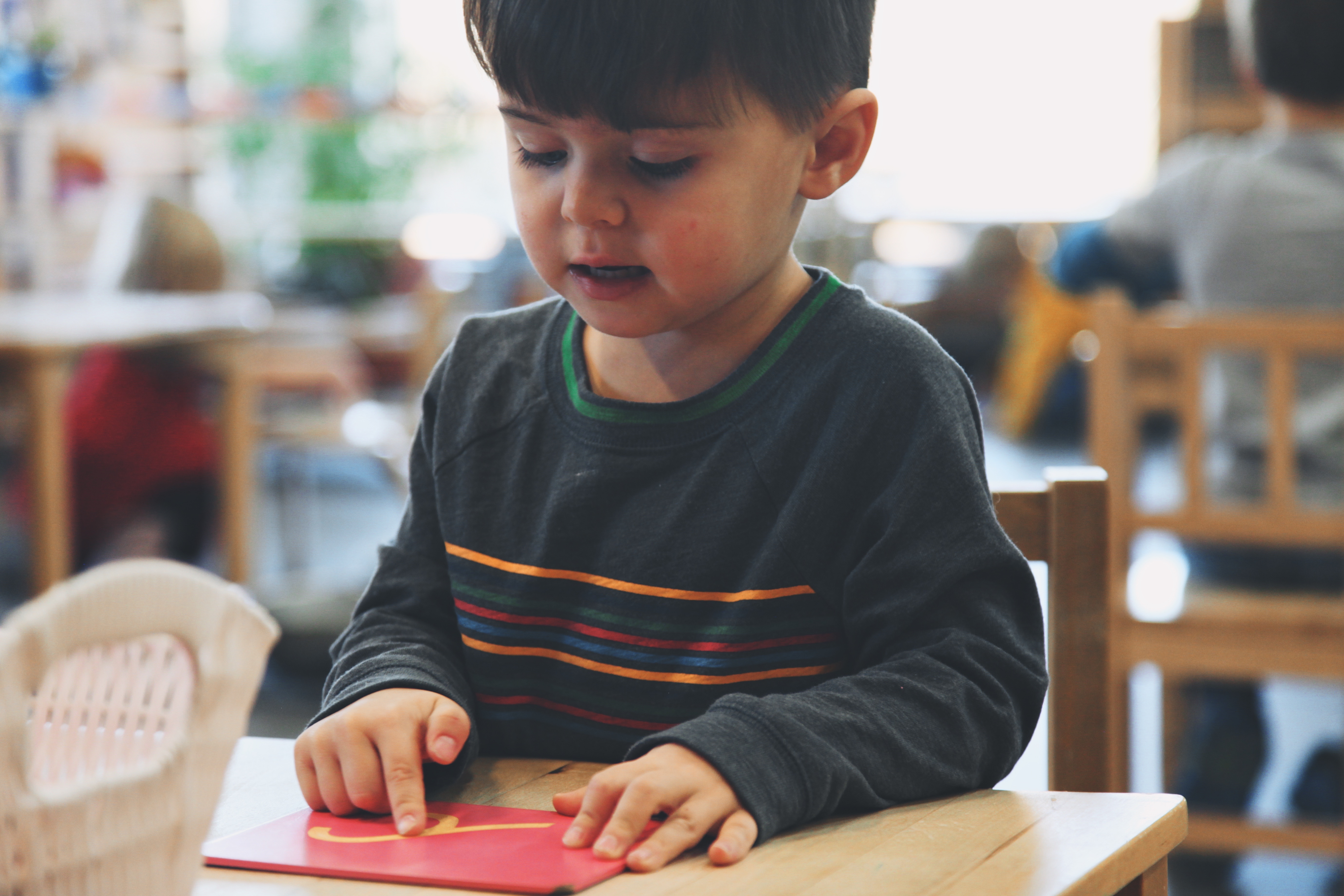
There’s any number of things that are different about the Montessori philosophy when compared to another early childhood education setting, or even an elementary school. One of those differences is the use of letter sounds rather than letter names when introducing literacy.
It’s rather unique. When many of us think of letters, how to best prepare our children for literacy, we think of the song beginning, “A, B, C, D…” Yet, it’s not uncommon for children in a Montessori classroom to be confidently reading at five, four, or even younger.
Even before we introduce symbols (better known as letters), we play games that help prepare children for literacy. We encourage conversations and help children tell stories. We play games with categories, like, let’s think of colors, or the names of children in our class, or birds.
Then, we add challenge in layers.
We graduate from, “let’s think of colors!” to “I’m thinking of a color that begins with ‘p,’ what is it?” (“p” in this instance is is a breathy sound with popping lips, the beginning sound in “pop,” rather than the more common “peee.”) A child might think of pink or purple. When they’re able to do that regularly, we ask what other sounds they hear, and finally ask them to slide those sounds together in order. This is what we call a Sound Game, and if you’re interested in how to play, we’ve recorded an example in the podcast that accompanies this post.

It’s the reverse of sounding-out: rather than seeing a letter and slowly making the sounds come together to make a word we recognize, we’re taking a word we know and dissecting all the parts to identify each individual sound. It’s sounding-out by ear, rather than visually.
Later, we’ll attach a symbol, a letter, to each of these sounds, and we call that writing.
So, why sounds?
Well, in English, though not in all languages, a letter makes multiple sounds. Think of the “A” sound, which can sound different depending on position, pairing, or even what language a word derives from. Take, for example, at, ate, boat, tuna, many, water, ball, ward, and garbage. In these nine words, we have nine different ways to pronounce the “A” sound, and they’re all correct. Is it any wonder any of us ever learns to read or to spell??
How do we choose the sound to introduce?
There’s a sound a letter makes most of the time, or whenever it’s not being modified by other letters, typically vowels. This is the sound we introduce to pair with the letter symbol. For instance, the letter highlighted in the previous example is introduced with the sound in ant, applesauce, anteater, hat, atom, animal. Words that utilize this letter as it’s sung in the song are typically paired with a final “e”, like ate, scrape, plate.
One thing that’s worth mentioning, we don’t change our pronunciation. We don’t mis-pronounce a word just because it doesn’t match the first sound we introduce. It’s part of the beauty and complexity and nuance of English, and it’s why we practice and practice, and then practice more.
This letter doesn’t always make this sound, but this is the sound it makes most of the time, and the sound it makes when it’s not modified. While we start with writing and then move to reading, probably one of the greatest gifts of starting with sounds is that it is a skill that helps children with lifelong learning.
Huh. All that from introducing “Aah,” rather than “A” to begin? Yes!
It’s one of the mysteries of the human brain that we don’t deeply or truly understand how children learn literacy. Reading is a human experience, but we can’t really explain how we get from talking to recognizing text on a page, even when we learned to read later in life. Because we don’t truly understand it, it makes it hard to teach reading, and is one of the reasons many children have a hard time with reading — the way we traditionally teach reading isn’t always effective. Here’s a fascinating NPR article with more on that.
As we become fluent in literacy, we read whole words, looking at a word and knowing it before we’re cognitive of the reading process. Because this is how adults read, and because adults are the ones developing curriculum and setting standards, and because we don’t truly understand how we learn to read, it’s easy to fall into the trap of teaching children to read the way adults do, essentially treating everything as a sight word to be memorized.
The exact question that this method doesn’t address, is the one Montessori solves from the start: what about words we don’t know, or words we haven’t read before?
Sight words are lovely for very common vocabulary, and eventually we all have thousands of sight words (think of the “wait, review” we go through when reading through versus thorough), but a child is just starting on this process, and even as readers with years of experience, we’ll come across words we don’t use frequently, or as any reader of Harry Potter, for example, will tell you — authors write words that we don’t know! Decoding, sounding out, helps us to read words we don’t know yet, and this is how we learn through reading, cultivate a lifetime of learning.
We start with sounds. What, at first, seemed so foreign, is actually so natural.